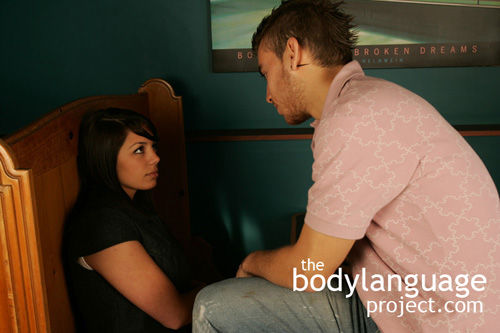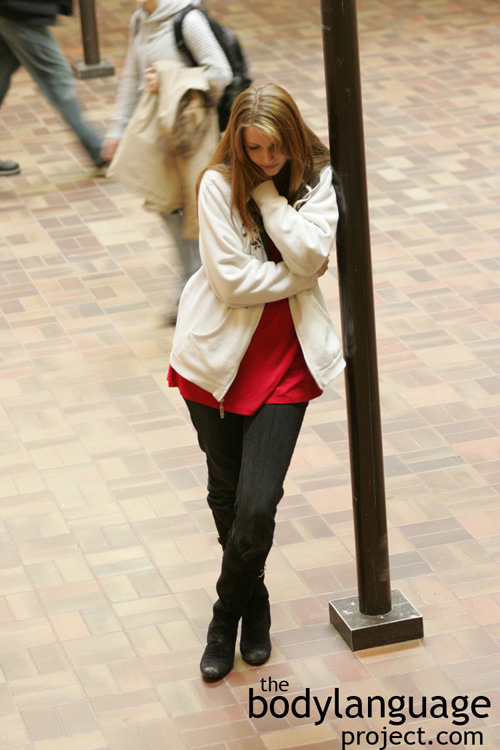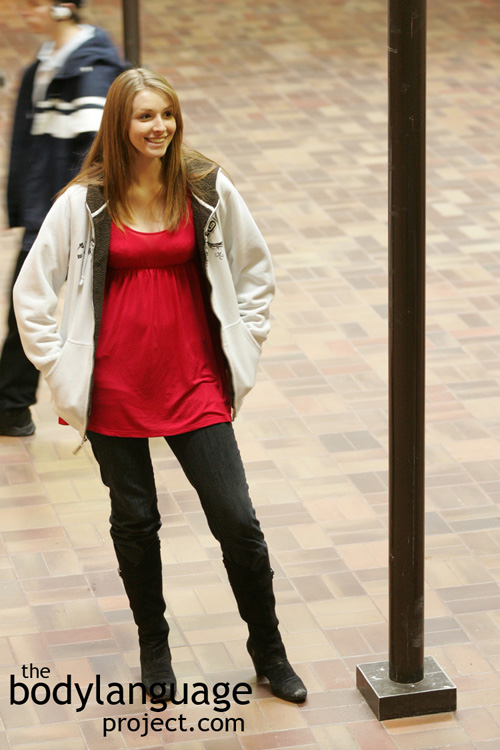When people meet and rejection is present we see:
[A] The disinterested party turns their body and head away at a half turn.
[B] An expressionless face is assumed.
[C] The toes are re-oriented away from the speaker toward an exit, or other people. Distance separating the speaker and listener may increase by taking a step away.
[D] Fidgeting increases, swaying from side to side, picking finger nails and so forth.
[E] Poor eye contact is present and the listener frequently looks away or down.
[F] No, infrequent, poor, or random regulators are given such as “mhum” and head nods.
[G] No engagement in the conversation, no addition of unique input.
[H] Opportunity to leave is actively sought despite lack of necessity.
Tag Archive for Expressionless Face
The Friendly Social Gaze
by Chris Site Author • March 5, 2013 • 2 Comments
When friends talk to one another they aren’t trying to peer into their souls, rather, they gaze. The gaze is non-threatening and like the intimate gaze, which follows, the eyes travel over the face in a specific pattern. In the friendly gaze, the eyes travel in a triangular pattern from eye to eye then to the mouth with some infrequent looks to the rest of the body. The reason we cast our eyes infrequently over other parts of the body is simply due to the reason that it is of less interest and of less value in friendship which is just the opposite of that which happens in the intimate gaze. With friends, gaze is brief, lasting only about three seconds followed by looking away. The research tells us that about seventy-five percent of the time eyes travel through the triangular pattern from the eyes to the mouth, ten percent of the time is spent on forays to the forehead and hair, and five percent to the chin, with the remaining time split on various other features.
After a period of gaze or mutual eye-contact both people will avert their eyes downward instead of left, right or upward. But if you are really in a comedic mood and want to put the fright into someone, break your eye contact by quickly looking up and taking a step backwards! They will most certainly think that something is about to fall on them which is the likely reason we rarely look up when breaking eye contact. Looking down, on the other hand is a symbol of submission whereas looking left or right can imply disinterest (or interest in something else), or a desire to withdraw from the conversation. Looking past or ‘through’ someone, by having an expressionless face, and unblinking eyes has the same affect, it places importance on other things aside from the conversation at hand. Of course, and as mentioned previously, feelings associated with improper eye contact is noted and held subconsciously, since for most people they are out of the normal range of awareness. That being said, people will attach powerful feelings and judgments to us based on how we use eye contact during conversation regardless of our true personalities.
The extreme end of negative thoughts and feelings related to eye contact comes from prolonged periods of unbroken eye contact – staring!
People As Objects
by Chris Site Author • March 5, 2013 • 0 Comments
This is why city streets are flooded with strangers behaving like zombies with expressionless faces as they hurry about. City folk seem inhuman and unemotional, detached, despondent and more than anything else, from an outsider’s perspective, they appear unhappy. Contrast this with a small city where eye contact is met with smiles, nods or waves and where doors are held open for others with words such as “thank you” provided in exchange.
So why do busily moving city slickers seem as though they are moving about a forest of trees, instead of a sea of actual living human beings with emotions and feelings? Why do city slickers dehumanize themselves? The answer lies in phenomenon termed “masking.” Masking is a coping strategy used to detach ourselves from our bodies so as to avoid negative feelings as we intrude on the personal space of others and as our personal space is intruded upon. Sometimes we even mask with outwardly aggressive emotions typified by New York streets. Cussing, yelling and other carrying on is a way to mask sensitivity and to hide caring. This is not to say that one becomes less human in New York, it just means that you can’t appear to be a wimp.
Masking helps people protect themselves from their emotions and is so potent that it is difficult sometimes to snap people from this hypnosis. Sometimes even making eye contact with others can be seen as offensive and returned only with an expressionless face, a glare, or even a snarl as if implying that the issue is that of another and not theirs.
Just like country folk expect and appreciate amicable greetings, smiles, waves and nods, city slickers expect and appreciate emotionless faces, few or no greetings and for people to mind their own business. Don’t confuse either situation for anything other than a coping mechanism. Taken in similar context, you might just see how similar each breed of people really is.
Here is a breakdown of ways we act in crowded places like subways and elevators:
[A] We stand or sit still, unmoving. The more crowded the area, the more frozen we remain.
[B] The face becomes blank and expressionless, but it is not due to negative thoughts but rather as a coping mechanism.
[C] Eye contact is avoided by looking at the floor or ceiling.
[D] Books, newspapers and other devices appear particularly interesting and immersive, serving to detach the self emotionally from the situation.
[E] Under extremely crowded conditions where touching is unavoidable, bodies appear to jostle to make space and if possible only allow shoulders and elbows to touch.



